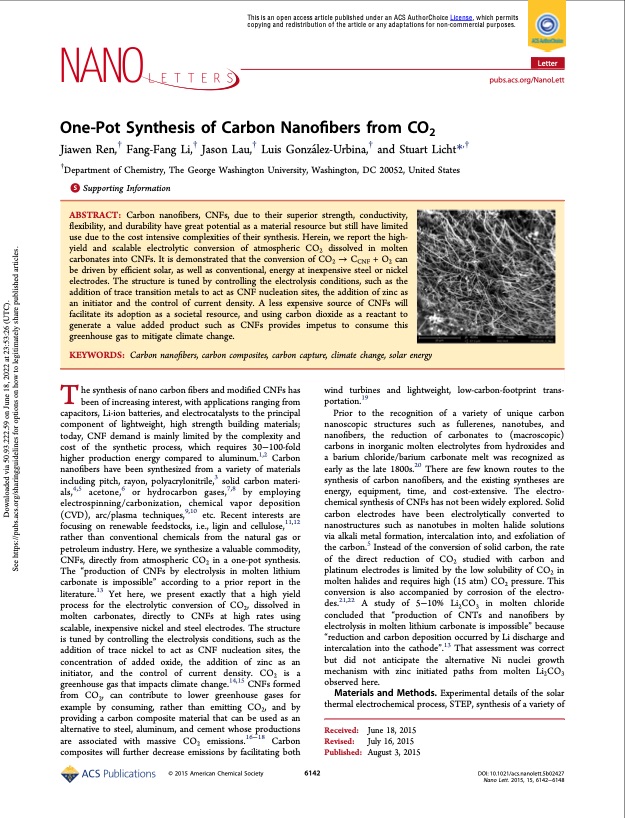
PDF Publication Title:
Text from PDF Page: 001
This is an open access article published under an ACS AuthorChoice License, which permits copying and redistribution of the article or any adaptations for non-commercial purposes. Letter One-Pot Synthesis of Carbon Nanofibers from CO2 JiawenRen,†Fang-FangLi,†JasonLau,†LuisGonzaĺez-Urbina,†andStuartLicht*,† †Department of Chemistry, The George Washington University, Washington, DC 20052, United States *S Supporting Information pubs.acs.org/NanoLett ABSTRACT: Carbon nanofibers, CNFs, due to their superior strength, conductivity, flexibility, and durability have great potential as a material resource but still have limited use due to the cost intensive complexities of their synthesis. Herein, we report the high- yield and scalable electrolytic conversion of atmospheric CO2 dissolved in molten carbonates into CNFs. It is demonstrated that the conversion of CO2 → CCNF + O2 can be driven by efficient solar, as well as conventional, energy at inexpensive steel or nickel electrodes. The structure is tuned by controlling the electrolysis conditions, such as the addition of trace transition metals to act as CNF nucleation sites, the addition of zinc as an initiator and the control of current density. A less expensive source of CNFs will facilitate its adoption as a societal resource, and using carbon dioxide as a reactant to generate a value added product such as CNFs provides impetus to consume this greenhouse gas to mitigate climate change. KEYWORDS: Carbon nanofibers, carbon composites, carbon capture, climate change, solar energy The synthesis of nano carbon fibers and modified CNFs has been of increasing interest, with applications ranging from capacitors, Li-ion batteries, and electrocatalysts to the principal component of lightweight, high strength building materials; today, CNF demand is mainly limited by the complexity and cost of the synthetic process, which requires 30−100-fold higher production energy compared to aluminum.1,2 Carbon nanofibers have been synthesized from a variety of materials including pitch, rayon, polyacrylonitrile,3 solid carbon materi- als,4,5 acetone,6 or hydrocarbon gases,7,8 by employing electrospinning/carbonization, chemical vapor deposition (CVD), arc/plasma techniques,9,10 etc. Recent interests are focusing on renewable feedstocks, i.e., ligin and cellulose,11,12 rather than conventional chemicals from the natural gas or petroleum industry. Here, we synthesize a valuable commodity, CNFs, directly from atmospheric CO2 in a one-pot synthesis. The “production of CNFs by electrolysis in molten lithium carbonate is impossible” according to a prior report in the literature.13 Yet here, we present exactly that a high yield process for the electrolytic conversion of CO2, dissolved in molten carbonates, directly to CNFs at high rates using scalable, inexpensive nickel and steel electrodes. The structure is tuned by controlling the electrolysis conditions, such as the addition of trace nickel to act as CNF nucleation sites, the concentration of added oxide, the addition of zinc as an initiator, and the control of current density. CO2 is a greenhouse gas that impacts climate change.14,15 CNFs formed from CO2, can contribute to lower greenhouse gases for example by consuming, rather than emitting CO2, and by providing a carbon composite material that can be used as an alternative to steel, aluminum, and cement whose productions are associated with massive CO2 emissions.16−18 Carbon composites will further decrease emissions by facilitating both © 2015 American Chemical Society 6142 wind turbines and lightweight, low-carbon-footprint trans- 19 nanoscopic structures such as fullerenes, nanotubes, and nanofibers, the reduction of carbonates to (macroscopic) carbons in inorganic molten electrolytes from hydroxides and a barium chloride/barium carbonate melt was recognized as early as the late 1800s.20 There are few known routes to the synthesis of carbon nanofibers, and the existing syntheses are energy, equipment, time, and cost-extensive. The electro- chemical synthesis of CNFs has not been widely explored. Solid carbon electrodes have been electrolytically converted to nanostructures such as nanotubes in molten halide solutions via alkali metal formation, intercalation into, and exfoliation of the carbon.5 Instead of the conversion of solid carbon, the rate of the direct reduction of CO2 studied with carbon and platinum electrodes is limited by the low solubility of CO2 in molten halides and requires high (15 atm) CO2 pressure. This conversion is also accompanied by corrosion of the electro- des.21,22 A study of 5−10% Li2CO3 in molten chloride concluded that “production of CNTs and nanofibers by electrolysis in molten lithium carbonate is impossible” because “reduction and carbon deposition occurred by Li discharge and intercalation into the cathode”.13 That assessment was correct but did not anticipate the alternative Ni nuclei growth mechanism with zinc initiated paths from molten Li2CO3 observed here. Materials and Methods. Experimental details of the solar thermal electrochemical process, STEP, synthesis of a variety of portation. Prior to the recognition of a variety of unique carbon Received: June 18, 2015 Revised: July 16, 2015 Published: August 3, 2015 DOI: 10.1021/acs.nanolett.5b02427 Nano Lett. 2015, 15, 6142−6148 Downloaded via 50.93.222.59 on June 18, 2022 at 23:53:26 (UTC). See https://pubs.acs.org/sharingguidelines for options on how to legitimately share published articles.PDF Image | One-Pot Synthesis of Carbon Nanofibers from CO2

PDF Search Title:
One-Pot Synthesis of Carbon Nanofibers from CO2Original File Name Searched:
acs.nanolett.5b02427.pdfDIY PDF Search: Google It | Yahoo | Bing
Sulfur Deposition on Carbon Nanofibers using Supercritical CO2 Sulfur Deposition on Carbon Nanofibers using Supercritical CO2. Gamma sulfur also known as mother of pearl sulfur and nacreous sulfur... More Info
CO2 Organic Rankine Cycle Experimenter Platform The supercritical CO2 phase change system is both a heat pump and organic rankine cycle which can be used for those purposes and as a supercritical extractor for advanced subcritical and supercritical extraction technology. Uses include producing nanoparticles, precious metal CO2 extraction, lithium battery recycling, and other applications... More Info
| CONTACT TEL: 608-238-6001 Email: greg@infinityturbine.com | RSS | AMP |